Ornamental cabbage: culture features, description of varieties with names and photos
In autumn, flower beds for many gardeners take on a dull look: the last asters, chrysanthemums, marigolds and other persistent crops fade away. Unusual cabbage will help to supplement the flower bed palette with bright and juicy tones until the very frost. Further in the article you will find the names of varieties of ornamental cabbage with photos and descriptions of the main characteristics.
The content of the article
Description of ornamental cabbage
Decorative cabbage, or curly brassica (Brassica oleracea), came to us from Japan... It was there that they not only appreciated the taste of the vegetable, but also saw its beauty. Having worked a little with the shape and color of the leaves, breeders have created many varieties that, with their appearance, will compete with the famous beautiful rose.
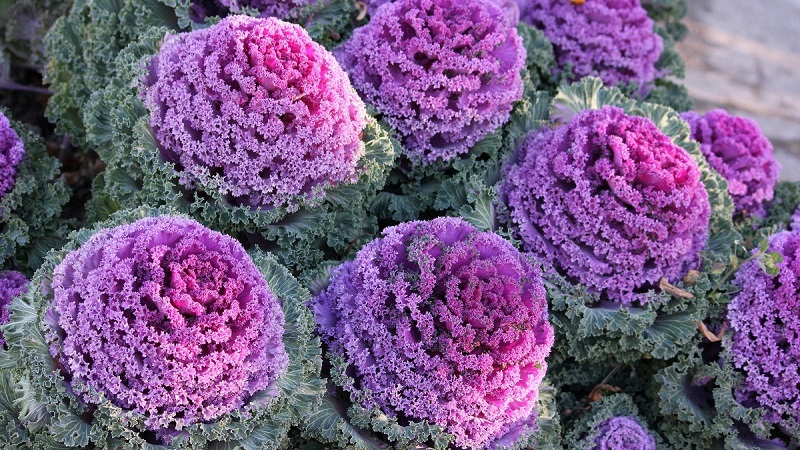
The plant is found in the wild in Greece, Italy and the coast of the Republic of Crimea. The openwork beauty is divided into two types in structure:
- head of cabbage forms a loose head of poorly closing leaves resembling a peony or a rose;
- leaf, or palm-shaped, the head of cabbage does not form, a leaf rosette with a heavily cut leaf blade of a lace or openwork shape.
Ornamental cabbage differs depending on the variety or hybrid type of dissection and color of the sheet.
Perennial or annual culture includes
Biennial ornamental cabbage: in the first year, it forms a rosette of leaves, and in the second year of life, it forms a peduncle and sets seeds. If you do not need to get your own seed crop, cabbage is grown as an annual.
How it grows: in a flowerbed or in a pot
Cauliflower is decorated with perennial beds, the so-called mixborders... By autumn, in such flower beds, many plants have already finished flowering. Perennial grasses (barley, miscanthus, gray fescue), asters, chrysanthemums and annuals that are not afraid of cold weather (cineraria, ageratum, marigolds, amaranth, cellosia) remain decorative. At this time, ornamental cabbage only reveals the full potential of the richness of color and luxurious texture of foliage.
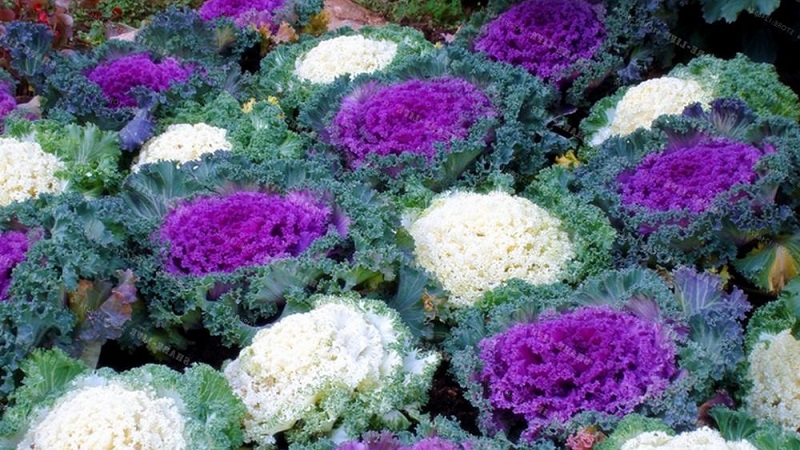
Where and with what plants the "vegetable rose" looks good:
- As a replacement for bulbous... After the primroses have faded, empty spaces remain in flower beds and flower beds. Loose heads of brassica will close them more economically than other flowers (half the seedlings will be required).
- Single planting on the lawn... Round flower beds from different combining varieties of culture look beautiful.
- Brassica rabat along the garden paths made of wood, stone, gravel, pine cuts or terracotta-colored garden tiles.
- Like a curbframing complex perennial flower beds.
- In openwork flower beds-arabesques... These are carpet flower beds, in which annual plants and ground cover crops are selected of the same height, as well as perennials that endure multiple haircuts.
- Like the original trunk circles... Heading leaves, as they close, completely block the access of light to weeds; moisture remains in such an elegant tree trunk circle longer.
The texture of ornamental cabbage leaves is combined with ceramics and wood... Attractive in the garden are flower beds, sheathed with a treated board or small diameter logs.
Attention! Cabbage tolerates multiple transplants if the root ball does not crumble much during digging.
Varieties that are distinguished by special beauty, unusual shape or size of the head of cabbage, landscape designers recommend planting in separate containers - pots, pots, baskets. In addition, flowering annuals, ground cover and creeping perennials - sedums, ivy, euonymus, can be planted in the pots. When drawing up a complex composition, it is important to ensure that the plants are combined with each other, one culture emphasizes the decorative qualities of the other.
The maximum capacity of such a container is 5-10 liters. Brassica, planted in a container, is convenient to carry to another place.
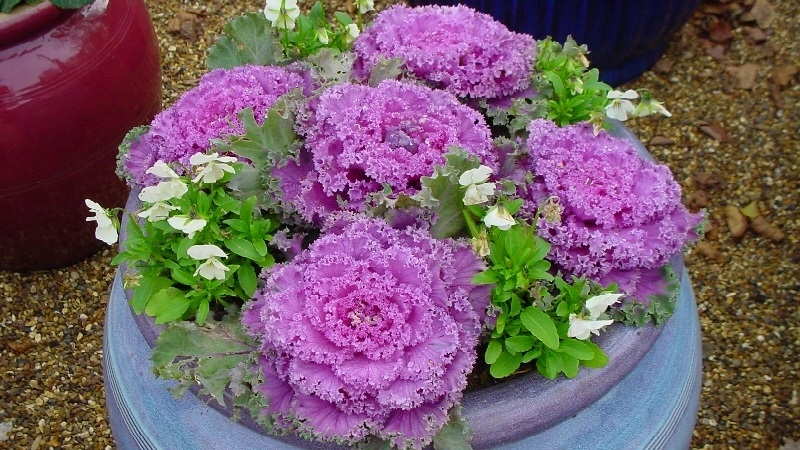
Flower-like cabbage varieties
The varieties and hybrids of ornamental cabbage are amazing. Japanese breeders, and then scientists around the world, worked to develop different colors, shapes of leaves and heads of cabbage.
Interesting on the site:
Sowing and cultivation features of Japanese cabbage (mizuna)
How to grow and care for ornamental peppers "Capsicum"
Decorative pumpkin "Little Red Riding Hood" and why to grow it
Gerda and Kai F1
Hybrid representing a mixture of 2 flowers: with emerald and dark purple leaves. These are tall plants, growing up to 50-70 cm, with strongly corrugated and openwork leaves. The appearance of the cabbage resembles a small palm tree.
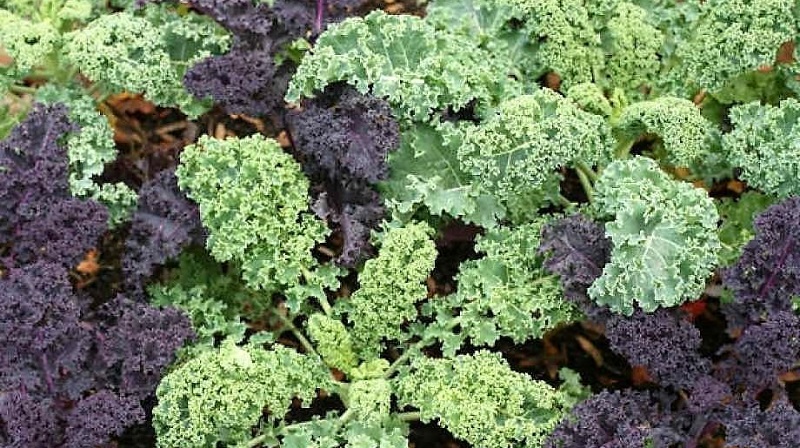
Features of the variety - high frost resistance (withstands air temperature drop to -15 ° C) and unpretentiousness to growing conditions. "Vegetable beauty" is good not only in a flower garden, but also in cooking: for decorating dishes, making summer soups and fresh salads.
Nagoya F1
Japanese hybrid, represented by low plants (25-30 cm) with a wide and loose rosette of leaves... The head of cabbage sits on a short stem. Each sheet has highly corrugated edges.
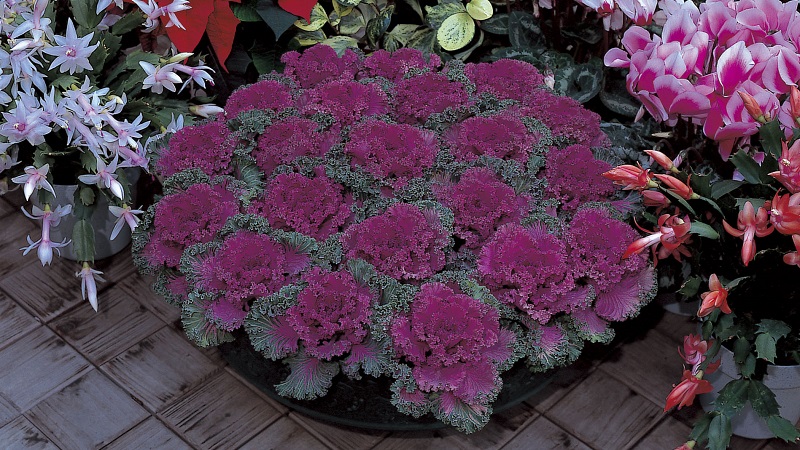
This hybrid has 3 varieties:
- white - with a white center and green outer leaves;
- red has a purple center and blue-green leaves along the edge;
- pink - the middle is bright pink, and the outer leaves retain their emerald color.
All of these hybrid varieties are not found in a mixture of colors, as in Kai and Gerda, but are sold separately with a patented name.
Reference. With cooling, the color of the middle leaves becomes brighter and fills almost the entire rosette.
Tokyo
The variety came from Japan. This is a small cabbage (up to 30 cm), in color and shape similar to an opened pink peony... The bright pink middle contrasts with the emerald green bottom leaves. The head of cabbage is loose, regular round shape. Leaves are rounded, bubbly, with slight waviness along the edge, slightly curled towards the center.

Tokyo, like the previous hybrid, has varieties with red, pink and white median leaves.
Osaka F1
Similar to the representatives of the Tokyo F1 hybrid. Differs in great growth (55-60 cm) and the ability to grow in partial shade... Withstands short-term frosts down to -8 ° C.
Serenade
Miniature brassica 22-25 cm high... Its rounded-flattened heads of cabbage with strongly wavy leaves immediately attract attention. The variety is compact, does not take up much space in the flower bed.
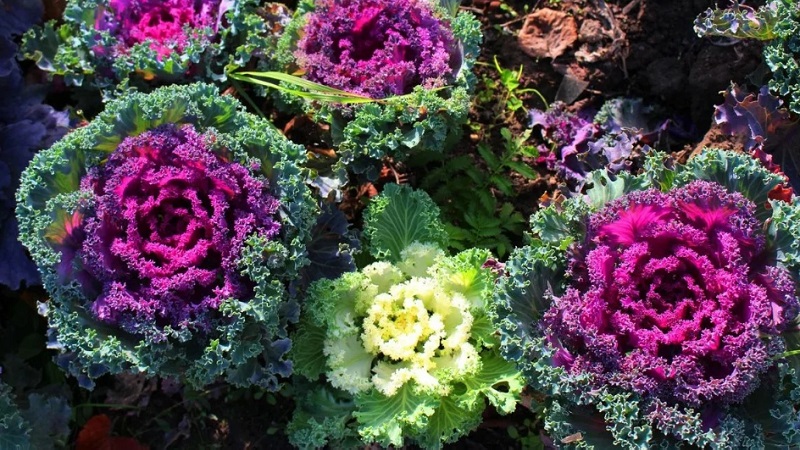
The outer leaves are colored dark green, while the inner ones can be cream, white, raspberry or pale pink.... Sometimes the variety is sold as a mixture of flowers. Serenade is not resistant to black leg, so it is recommended to water crops and seedlings in moderation.
Sunrise F1
Bouquets of this cabbage can be mistakenly confused with bush roses.... From one long stem (45 cm), several thin stems grow, each of which is crowned with a rosette, in the shape of repeating a glass of a rose.
Inner leaves are two- or three-colored: green at the edges, then white, and pink in the very center. The transition from one color to another is smooth. Florists use Sunrise in bouquets, picking off all the lower leaves.
Read also:
Russian circle
A mixture of lacy cabbage varieties. Heads are compact (25-30 cm high), round, like a rose... The leaves are rounded, with a smooth edge. The lower leaves are dark green. Coloring of the middle of various shades of yellow, red (there are varieties with a rich red center), cream and green. The veins on the leaf blade and its edge are also painted in a bright color.

If a plant is transplanted into a pot in the fall, it will decorate the windowsill and retain its decorative effect until the New Year. Well worth the cut. Photophilous and demanding on soil fertility.
Lace Frill F1
Plant height - 40-50 cm. Cabbage leaves are strongly corrugated, lacy... The rosette is rounded, flattened. The variety with a violet-blue middle looks especially impressive. In addition, there are varieties with a red and white center.
Coral Queen
A hybrid with a red center and gray-green marginal leaves will help to grow real coral reefs in the garden. An adult plant is 40 cm tall and 50 cm in diameter... The leaves of the culture are strongly dissected, with their structure reminiscent of coral. The variety tolerates light frosts down to -5 ° C. Does not droop even after the first snow falls.
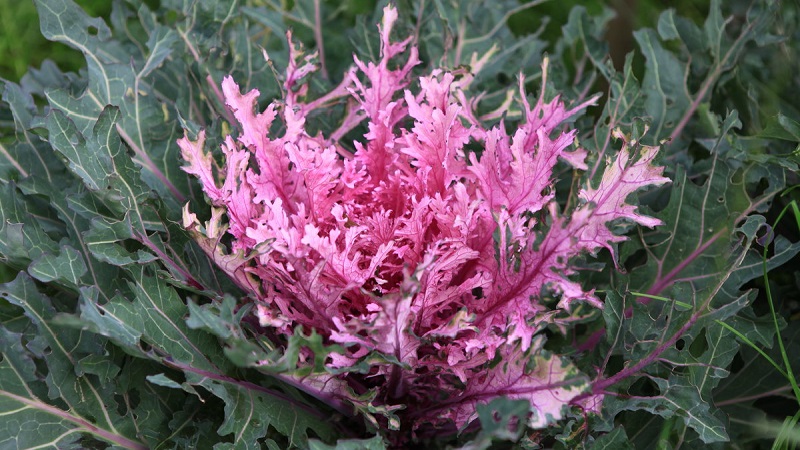
Lark's Tongue
The value of the variety is a strictly pyramidal plant shape and a majestic growth of up to 1.5 m... The leaves are large, on a large petiole, with a total length of 70 cm, flat, lacy, with a scalloped edge. This leafy form of cabbage does not form a head of cabbage.
The lower leaves of green color smoothly turn into rich pink, snow-white or purple.
Conclusion
Each of the popular varieties and hybrids of ornamental cabbage deserves a place on the flowerbed and on the table - almost all ornamental brassica is edible. Their leaves do not taste bitter and are used to decorate various dishes, make summer soups and prepare fresh vegetable salads.